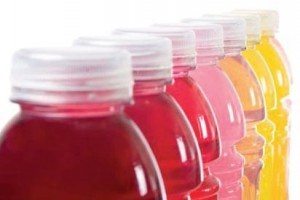Sports Drinks: Back to Basics
August 29, 2019

Remember when we used to just drink water during exercise? Me neither. Sports drinks have been around since the 1960s, and for good reason. During this time we learned what electrolytes are lost in sweat and diarrhea. We learned that athletes perform better when replace these electrolytes. We also learned that dehydrated individuals absorb fluid and electrolytes better when they consume a drink that contains glucose. When used in the right amount, the glucose molecule helps carry sodium and fluid from the small intestine into the bloodstream. In the 1980’s we learned that consuming carbohydrates during exercise improves performance. We also learned that using a complex carbohydrate, like rice, in place of simple sugar, improves fluid absorption.
This is your basic sports drink formula: carbohydrate made of glucose, sodium, chloride, potassium and either citrate or bicarbonate to correct the acidity associated with fluid loss. Since the 1960’s, hundreds of hydration formulas have been developed to treat any hydration condition. Some are quite complicated and contain way more than the basics. What has changed? Here is what you need to know.
Water is still critical to hydration. Before sweating and diarrhea enter the equation, we can meet our basic fluid needs with water and electrolyte needs through food. Most Americans get more than enough salt (sodium chloride) and fruits and vegetables should meet our potassium needs. Other nutrients minimally lost in sweat (calcium, magnesium, and zinc) should be sufficiently met through diet as well. We don’t add them to sports drinks because they are minimally lost and take away from the hydrating power of a sports drink. Even “professional sweaters” will be better served by a sports drink if they meet their baseline fluid and electrolytes though water and a healthy diet.
When sweat rates exceed a normal daily amount or when diarrhea pays an unexpected visit, water is not enough. A normal daily amount of sweating is about 500-1,500 ml per day. This is really hard to quantify. If you are sweating for an hour straight, assume you have exceeded this amount. When athletes drink only plain water during exercise, they drink less than what they need and don’t fully rehydrate. Sport drinks serve two purposes. First, they should have a slight sweetness, thus encouraging individuals to drink enough to meet their fluid requirements. Second, they should provide the proper ingredients behind that good taste to replace electrolytes lost. These electrolytes help retain consumed fluid and prevent cramping.
The carbohydrates used in a sports drink is critical. Drinks that are too sweet actually discourage drinking or individuals will dilute them and inadvertently dilute the electrolytes. Many products use fructose or sucrose (sucrose is glucose + fructose). This form of carbohydrate is a simple sugar, is really cheap, and very sweet. The problem is, this same carbohydrate used in sodas makes for a poor quality product for a sports drink. “Organic” sugar is not any better. Fructose does not immediately convert to glucose, which we need immediately during exercise for energy. Fructose also does not carry sodium. Only glucose does. Rice is a long chain of glucose. The longer chain causes less gastrointestinal discomfort, and as we learned in the 1980’s, is way better at hydrating when the body is stressed.
If you used 80 grams of glucose or sucrose in a liter of sports drink, it would really aggravate your stomach. This is because the small particles takes longer to leave the stomach and pulls water from the bloodstream into the small intestine. Wrong way! Rice is a long chain, fewer particles, leaves the stomach fast and goes from the intestine into the blood fast. 80 grams of a rice-based carbohydrate in a sports drink will cause no issues. Most sports drinks are 40-60 grams of carbohydrate per liter. Athletes only need more than this when doing evets of longer duration. Many of these athletes struggle with their nutrition. This is often why.
The required electrolytes in a sports drink are just sodium, chloride, and potassium. The more minerals, vitamins, herbs, or amino acids added to a sports drink take away from the basic purpose, hydrating. A sports drink is not a multivitamin. If you need more vitamin C, eat a kiwi. If you need calcium, magnesium or zinc, get it through food. We lose more magnesium in our daily urine than in sweat. Even children stricken with cholera who needed zinc and magnesium did not get it in their ORS (oral rehydration solution). They got it in a separate, controlled dose.
So what about the formulas that are an “IV in a bottle” or salt tablets or vitamin enhanced sports drinks. Our economy was built upon selling people things they don’t need. Sports drinks are no different. People think they are getting a better product or doing their body good by getting more ingredients. Unfortunately, the opposite is true.
Take sodium for example. A sports drink should contain 100-200 mg per 8 oz serving or 400-800 mg per liter. If you take in more than this, you will just pee it out or sweat it out so your blood sodium levels stay normal. More is just not necessary. There are specialized products that contain 400-500 mg per 8 oz. These products are used to treat acute dehydration and diarrhea. This high level of sodium, along with carbohydrate, helps bring fluid into the blood stream and the salt helps you retain the water. The other fact about sodium is a lot of products use sodium bicarbonate or sodium citrate and don’t use sodium chloride. Many leave out chloride altogether! Many athletes don’t realize this and think they need more salt. Taking salt tablets will actually cause dehydration because your body will try to pee out the unneeded salt. They will also irritate your stomach and esophagus. They really just needed a properly formulated sports drink to begin with.
Cerasport® is your properly formulated sports drink and Ceralyte® is your properly formulated ORS. Rice is our carbohydrate, stevia is our sweetener. Life is complicated. Hydration should not be. Use rice in your sports drink, save the sugar for your cookies.
For more information on Cera Products, please reach out to our dietitian, Trisha, at tstavinoha@ceraproducts.us.
Established in 1993, trusted by the military since 1999.
Share:
Leave a comment
Comments will be approved before showing up.




